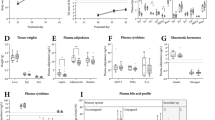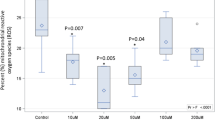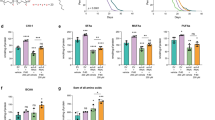Abstract
Mammals cannot naturally produce omega-3 (n-3) fatty acids — beneficial nutrients found mainly in fish oil — from the more abundant omega-6 (n-6) fatty acids and so they must rely on a dietary supply1. Here we show that mice engineered to carry a fat-1 gene from the roundworm Caenorhabditis elegans can add a double bond into an unsaturated fatty-acid hydrocarbon chain and convert n-6 to n-3 fatty acids. This results in an abundance of n-3 and a reduction in n-6 fatty acids in the organs and tissues of these mice, in the absence of dietary n-3. As well as presenting an opportunity to investigate the roles played by n-3 fatty acids in the body, our discovery indicates that this technology might be adapted to enrich n-3 fatty acids in animal products such as meat, milk and eggs.
Similar content being viewed by others
Main
The fat-1 gene of C. elegans encodes an n-3 fatty-acid desaturase enzyme that converts n-6 to n-3 fatty acids and which is absent in most animals, including mammals2,3. We transferred this fat-1 gene into mice and raised them alongside wild-type mice maintained on an identical diet that was high in n-6 but deficient in n-3 fatty acids. However, the fatty-acid profiles of the two groups turned out to be quite different (Fig. 1). The tissues of wild-type animals contain polyunsaturated fatty acids that are mainly (about 98%) n-6 linoleic acid (designated an 18:2 n-6 fatty acid as it has 18 carbon atoms and 2 double bonds, one at position n-6) and arachidonic acid (AA, 20:4 n-6), with very little n-3 fatty acid (from a dietary source). By contrast, the transgenic animal tissues are rich in n-3 polyunsaturated fatty acids, including linolenic acid (18:3 n-3), eicosa-pentaenoic acid (EPA, 20:5 n-3), docosa-pentaenoic acid (DPA, 22:5 n-3) and docosahexaenoic acid (DHA, 22:6 n-3).
a, b, Traces from lipid from a, a wild-type mouse, and b, a fat-1 transgenic mouse (heterozygote). The expression vector used for microinjection contained the humanized fat-1 sequence (with modification of codon usage) and a chicken β-actin promoter and cytomegalovirus enhancer, which allow high and broad expression of the transgene in mice6,7. Both the wild-type and transgenic mice were 8-week-old females that were fed on the same diet, which was high in n-6 but low in n-3 fatty acids. The lipid profiles show that concentrations of n-6 polyunsaturated acids (18:2 n-6, 20:4 n-6, 22:4 n-6 and 22:5 n-6) are lower and levels of n-3 fatty acids (asterisks) are markedly higher in transgenic (b) than in wild-type (a) muscle. (Homozygotes and heterozygotes have a similar phenotype.)
The concentrations of n-6 linoleic and arachidonic acids in the tissues of the transgenic mice are significantly reduced, indicating that n-6 fatty acids have been converted to n-3, causing the ratio of n-6 to n-3 to drop from 20–50 to almost 1. This n-3 enrichment at the expense of n-6 gives a balanced ratio of n-6 to n-3 and of AA/(EPA+DPA+DHA) in all of the organs and tissues tested (Table 1). Transgenic skeletal muscle contains more EPA than DHA, but DHA is the dominant n-3 fatty acid in other organs.
We have examined the tissue fatty-acid profiles in four generations of transgenic mouse lines (homozygote or heterozygote) and find consistently raised n-3 fatty acids, indicating that the transgene is functionally active in vivo and transmittable. The transgenic mice appear to be normal and healthy.
Efforts have been made to incorporate n-3 fatty acids into the food supply1,4 because of their health benefits and concern over the high n-6:n-3 ratio in Western diets. Our findings suggest a new strategy for producing food that is enriched in n-3 fatty acids from livestock carrying an n-3 desaturase trans-gene. At present, farm animals are fed fishmeal and other marine products, but this is time-consuming and costly, and is limited by the quantity of the source5. Production of n-3 fatty acids by the animals themselves would be a cost-effective and sustainable way of meeting the increasing demand; the ideal n-6:n-3 ratio of about 1 could be achieved by consuming foods containing this ratio and without introducing stringent dietary changes.
Our transgenic mice also offer a model for investigating the biological functions of n-3 fatty acids and the importance of the ratio of n-6:n-3 in disease prevention and treatment. Specific effects of n-3 fatty acids and of the n-6:n-3 ratio can be tested in different organs and tissues — for example, they may alter gene expression or physiological activity during the life cycle. Our mouse lines could be genetically backcrossed with mouse disease models to test the effects of n-3 fatty acids on the pathogenesis and treatment of those diseases.
References
Simopoulos, A. P. et al. (eds) World Rev. Nutr. Diet Vol. 83 (Basel, Karger, 1998).
Spychalla, J. P., Kinney, A. J. & Browse, J. Proc. Natl Acad. Sci. USA 94, 1142–1147 (1997).
Kang, Z. B. et al. Proc. Natl Acad. Sci. USA 98, 4050–4054 (2001).
Simopoulos, A. P. & Cleland, L. G. (eds) World Rev. Nutr. Diet Vol. 92 (Basel, Karger, 2003).
Naylor, R. L. et al. Nature 405, 1017–1024 (2000).
Niwa, H., Yamamura, K. & Miyazaki, J. Gene 108, 193–199 (1991).
Okabe, M. et al. FEBS Lett. 407, 313–319 (1997).
Author information
Authors and Affiliations
Corresponding author
Ethics declarations
Competing interests
The authors declare no competing financial interests.
Rights and permissions
About this article
Cite this article
Kang, J., Wang, J., Wu, L. et al. Fat-1 mice convert n-6 to n-3 fatty acids. Nature 427, 504 (2004). https://doi.org/10.1038/427504a
Issue Date:
DOI: https://doi.org/10.1038/427504a
This article is cited by
-
The endoplasmic reticulum stress protein GRP94 modulates cathepsin L activity in M2 macrophages in conditions of obesity-associated inflammation and contributes to their pro-inflammatory profile
International Journal of Obesity (2024)
-
Chitosan-based delivery of fish codon-optimised Caenorhabditis elegans FAT-1 and FAT-2 boosts EPA and DHA biosynthesis in Sparus aurata
Reviews in Fish Biology and Fisheries (2024)
-
Calcific aortic valve disease: mechanisms, prevention and treatment
Nature Reviews Cardiology (2023)
-
Bioproduction of n-3 polyunsaturated fatty acids by nematode fatty acid desaturases and elongase in Drosophila melanogaster
Transgenic Research (2023)
-
Interactive Effects of Omega-3 Polyunsaturated Fatty Acids and Secondhand Smoke in Mice and Human Subjects
Cardiovascular Toxicology (2021)
Comments
By submitting a comment you agree to abide by our Terms and Community Guidelines. If you find something abusive or that does not comply with our terms or guidelines please flag it as inappropriate.




